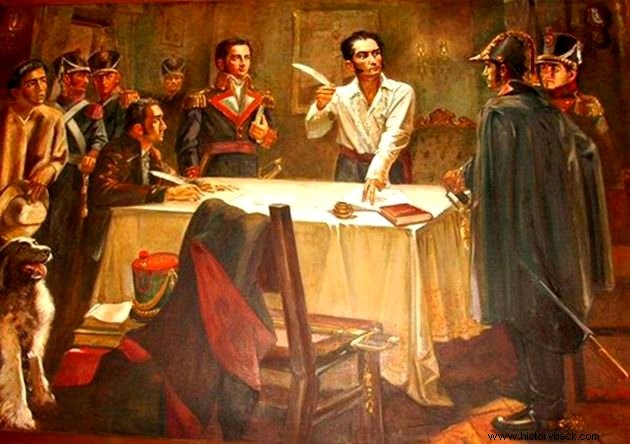The Independence from the Spanish colonies in America occurred after nearly 300 years of colonial rule and resulted in the formation of 18 new countries.
Background
The emancipation movements were divided into three phases called:
- Precursor movements - 1780 to 1810
- Failed Rebellions - 1810 to 1816
- Victorious Rebellions - 1817 to 1824
The Spanish colonial empire, since the 18th century, was divided into four viceroyalties and four general captaincies:
- New Spain :composed of Mexico and part of the United States.
- New Grenade :integrated by the current territories of Colombia, Panama and Ecuador,
- Peru :corresponding to Peru;
- Rio de la Plata :constituted the area equivalent to Argentina, Uruguay, Paraguay and Bolivia.
For their part, the captaincies-general are equivalent to the territories of Cuba, Guatemala, Venezuela and Chile. See also:Spanish America
Causes
The independence of the Spanish American colonies occurred in the 18th century when ideas such as liberalism and autonomy began to conquer the criollas elites. .
In addition, we can cite as causes:
- The influence of US Independence;
- The desire to replace the colonial pact with free trade;
- The expansion of the Napoleonic Empire that occupied Spain and overthrew King Ferdinand VII;
- Haiti's military support;
- The financial support of England.
The first military actions received harsh repressions from the metropolis. Although they took place in a disorganized and untimely manner, they helped colony residents to question the exploitation system and created the conditions for future wars.
Among the most important movements is the one led by Tupac Amaru II, who fought from 1780 onwards for the independence of Peruvian territory.
In the first uprising, 60,000 Indians were killed by the Spanish and Tupac Amaru was arrested and executed. Beginning in 1783, similar revolts took place and were similarly suppressed in Venezuela and Chile.
The main Venezuelan leader was Francisco de Miranda (1750-1816) who, in 1806, took the first steps towards the independence of the colonies from Spain. Miranda followed the North American model, as well as the Haitian one, when the slaves were freed from France.
Failed Rebellions (1810 to 1816)

The accession of José Bonaparte (1778-1844) to the Spanish throne in 1808 intensified the liberation process. The Spaniards faithful to the king gathered in Cádiz to resist French rule.
For their part, the criollos , through the cabildos , guaranteed their loyalty to King Ferdinand VII by not recognizing José Bonaparte as King of Spain.
The criollos movement , however, changed from loyalty to the understanding that they could be emancipated and freedom movements intensified after 1810.
Contrary to what happened with Brazil, at this first moment, the independence movements did not count on the help of England. After all, this country was fighting the Napoleonic Empire.
Only in 1815, when Napoleon was defeated by English troops, did the Spanish colonies receive support for independence from Great Britain.
With an interest in new trade agreements, England supported the uprisings that began in 1817 and lasted until 1824.
Victorious Rebellions (1817 to 1824)

Among the main leaders is Simón Bolívar (1783-1830) whose military campaign resulted in the independence of Colombia, Ecuador and Venezuela.
In exchange for military support provided by the Haitians, Bolívar pledged to abolish slavery in all territories he conquered.
The independence of Argentina, Chile and Peru was commanded by José de San Martín (1778-1850). Both leaders met in Guayaquil on July 27, 1822, in order to agree on political strategies for the new countries.
When most of the Spanish colonies had already gained their independence, the United States proclaimed the Monroe Doctrine.
With the motto "America for Americans ", the doctrine was summed up in the fight against military interventions by European countries to the nations of the American continent.
Decades later, the Americans would do the same, expelling the Spaniards from Puerto Rico and Cuba.
Consequences
- Despite being the wish of leaders like Simón Bolívar, the Spanish colonies fragmented into several countries after the Panama Conference.
- The creole aristocracy came to govern the emancipated sovereign states.
- The economy continued to be based on the export of raw materials and to be dependent on the industrialized production of European nations.
- Maintenance of the colonial structure where whites were the elite and Indians and mestizos were considered inferior.
Abstract
Check below the dates of emancipation of the colonies of the American continent:
- United States - 1776
- Canada - 1867
- Haiti - 1804
- Argentina - 1810
- Paraguay - 1811
- Chile - 1818
- Mexico - 1821
- Peru - 1821
- Brazil - 1822
- Bolivia - 1825
- Uruguay - 1828
- Ecuador - 1830
- Venezuela - 1830
- New Granada - 1831
- Costa Rica - 1838
- El Salvador - 1838
- Guatemala - 1838
- Honduras - 1838
- Dominican Republic - 1844
- Colombia - 1886
- Cuba - 1898
- Panama - 1903
Curiosities
Most of the flags of Spanish American countries were created at the time of independence. How about reading about its history and learning more about it?
- Argentina flag
- Flag of Chile
- Flag of Paraguay
- Flag of Uruguay
- Mexico flag
Read Also :
- Causes of Brazil's Independence
- Independence of the United States
- Latin America
